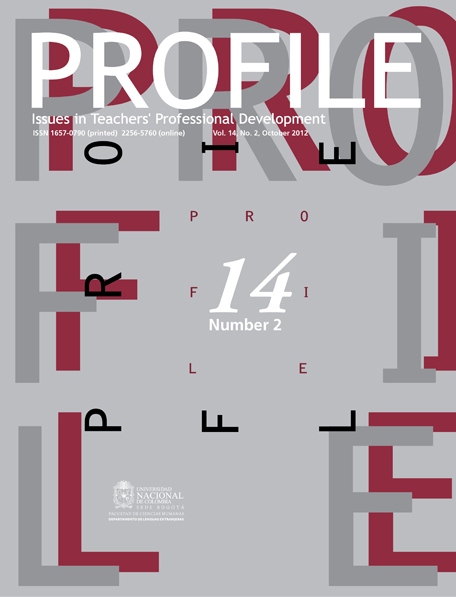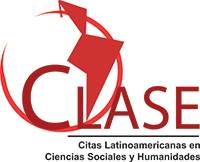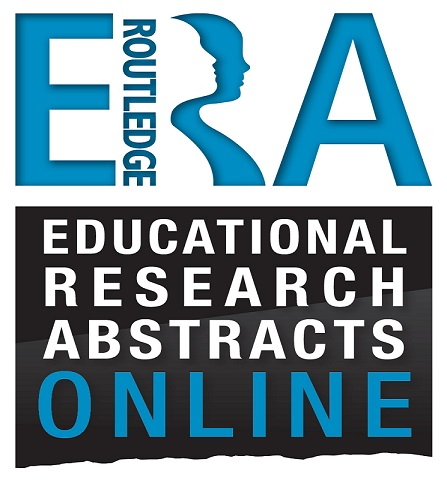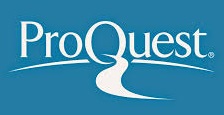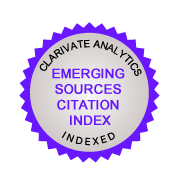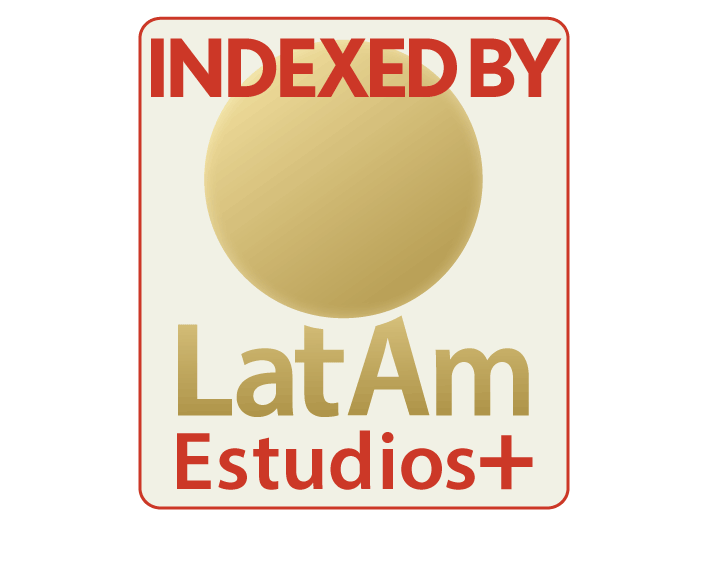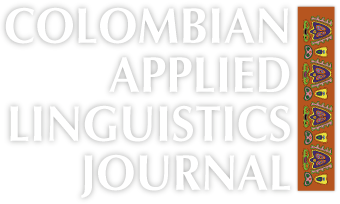Understanding Beliefs, Teachers’ Beliefs and Their Impact on the Use of Computer Technology
Hacia la compresión de las creencias, convicciones del educador y su impacto en el uso de la tecnología
Keywords:
English as a foreign language, teachers’ beliefs, using technology (en)Creencias del educador, inglés como lengua extranjera, uso de la tecnología (es)
This theoretical review addresses the construct of beliefs in education and English as a foreign language, and their impact when integrating technology. A thorough definition and categorization of teachers’ beliefs will be provided. In addition, studies conducted in various educational settings examining the effects of teachers’ beliefs and the use of technology will be reviewed. Additional information on models attempting to explain human behavior and the use of computers will be presented as well in order to discuss these research results in light of local efforts made to solve the gap of integrating technology through the Computadores para Educar Program in Colombian public schools.
Este artículo gira en torno al concepto y la categorización de las creencias sobre la educación y la enseñanza del inglés como lengua extranjera, y se estudia cómo la tecnología incide en dichas creencias cuando esta se integra. Además de revisar varios estudios acerca de los efectos de dichas creencias respecto al uso de la tecnología, se presentan tanto los modelos investigativos y estudios que han intentado describir el comportamiento humano frente al uso de computadores como sus resultados. Estas investigaciones son relevantes para el programa Computadores para Educar, con el que se busca combatir la falta de acceso a la tecnología en Colombia, y beneficiar a los colegios públicos.
Understanding Beliefs, Teachers’ Beliefs and Their Impact on the
Use of Computer Technology
Hacia la
compresión de las creencias, convicciones del educador y su impacto en
el uso de la tecnología
Héctor
Alejandro Galvis*
Universidad de La
Salle & Universidad de Los Andes, Colombia
*alejandro.galvis.hg@gmail.com
This article was received on August 17, 2011, and
accepted on June 26, 2012.
This theoretical review addresses the construct of
beliefs in education and English as a foreign language, and their impact when
integrating technology. A thorough definition and categorization of
teachers’ beliefs will be provided. In addition, studies conducted in
various educational settings examining the effects of teachers’ beliefs
and the use of technology will be reviewed. Additional information on models
attempting to explain human behavior and the use of computers will be presented
as well in order to discuss these research results in light of local efforts
made to solve the gap of integrating technology through the Computadores
para Educar Program in
Colombian public schools.
Key words: English as a
foreign language, teachers’ beliefs, using technology.
Este
artículo gira en torno al concepto y la categorización de las
creencias sobre la educación y la enseñanza del inglés
como lengua extranjera, y se estudia cómo la tecnología incide en
dichas creencias cuando esta se integra. Además de revisar varios estudios
acerca de los efectos de dichas creencias respecto al uso de la
tecnología, se presentan tanto los modelos investigativos y estudios que
han intentado describir el comportamiento humano frente al uso de computadores
como sus resultados. Estas investigaciones son relevantes para el programa
Computadores para Educar, con el que se busca combatir la falta de acceso a la
tecnología en Colombia, y beneficiar a los colegios públicos.
Palabras clave: creencias del
educador, inglés como lengua extranjera, uso de la tecnología.
Introduction
Computers and the Internet are becoming both widely
used and widely researched in the language classroom. Computer technology in
education is a new trend that seems to offer many advantages compared to
traditional instruction. Specifically, Butler-Pascoe and Wiburg (2003) state that the use of computer technology
fosters interaction and presents students’ language in a graphically and
linguistically enhanced manner. Also, computer technology can be used
for task or problem-solving activities. Likewise, Chapelle
(2003) states that using computer and Internet technology can enhance second
language acquisition due to the differences as to how input and information
processing takes places through the use of computer technology, not to mention
the benefits attributed to distance education in terms of mobility and
efficacy.
Unfortunately, the desire to use technology is not
always as successful as wished due to first-order barriers hindering access to
computers and the Internet. In fact, local efforts have been in action in order
to fight the inevitable digital divide inherent to technology in education
through the Computadores para Educar (CPE) program since 2002, in which thousands of
computers have been collected from both the public and private sector in order
to fight the lack of access to technology in low-income and rural communities
in the Colombian territory. CEP not only collects, but also refurbishes and
distributes computers to public schools.
Since computers are acquiring a decisive role in
education and society in general, the implementation of computer technology and
its success has become of particular interest, but its success does not merely
depend only on abundant economic investments. In fact, in education, it has
been found that final users (i.e. educators) have an influential role in the
successful implementation of technology. One of the factors affecting the
implementation of computer technology is educators’ own teaching profile,
which refers to how an educator’s performance fits into a pedagogical
theoretical trend. Mainly, teaching profiles have been described to be either
traditional or constructivist; Tondeur, Hermans, Van Braak, and Valcke (2008) have found that traditional teaching profiles
are associated with low-computer use, whereas constructivist teaching profiles,
in which students take an active role in learning, are associated with higher
computer use. Surprisingly, researchers have found that teachers holding both a
combination of traditional and constructivist teaching profiles represented the
highest degree of computer use.
In a similar study, Windschitl
and Sahl (2002) found that teachers’ beliefs
about the potential of their students, about teaching, and, particularly, the
role of computers in education had a decisive impact on the success or failure
of implementing technology. In addition, Windschitl
and Sahl found that even if teachers abandoned the
idea of implementing computer technology in the classroom, there was an a
posteriori effect on their teaching practices, leading such practices to become
more constructive as compared to before the use of computer technology in the
classroom.
Beliefs are a major influencing factor in many areas
of education (Borg, 2003), and technology is not exempt from this influencing
phenomenon. In fact, teachers’ beliefs have proved to be able to
challenge government and school efforts to implement computer technology. Such
beliefs have often served to be a deterrent in the use of computer technology
in the classroom (Ertmer, 2005). For this reason, the
main purpose of this paper is to provide a general overview of the effects of
teachers’ beliefs in the use of technology in the language classroom and
some local considerations to bear in mind when encouraging educators to use
technology. Due to the scarcity of studies in the area, this paper will present
both studies examining the effects of teachers’ beliefs in using
technology in general and in language education. It is hoped that this will
bring to light the reasons favoring or inhibiting the development of positive
and negative beliefs teachers hold about the use of computer technology, and
how administrators and educational public policy need to address the complexity
of beliefs in order to succeed in the implementation of computer technology in
schools.
This paper consists of three sections. Section one
will provide a review of the various attempts to define the construct of
beliefs, plus a detailed explanation of the type of beliefs first identified by
Rokeach (1968). Section two will present a review of
studies examining the effect of beliefs in computer technology use in both
general and language education. Section three will explore the interaction of
beliefs, attitudes, intentions, and action. For this purpose, the Venkatesh, Morris, Davis, and Davis’ (2003)
“Unified Theory of Acceptance and Use of Technology” together with
Lawrence’s (2001) model of teachers’ beliefs will be explained in
detail in order to gain insight into beliefs being not as an isolated
construct, but as one interacting with both internal and external factors.
Section four will provide concluding remarks and recommendations for further
research in the field of implementation of computer technology culture, and
identity in relation to computer use.
Beliefs
Pajares (1992) presents beliefs as a messy construct, and one difficult to
disentangle from similar concepts. Pajares states
beliefs usually overlap with close psychological terms such as knowledge,
attitude, opinion and ideology. In this perspective, a definition for beliefs
is “at best a game of player’s choice” (p. 309). An early
attempt to systematize the concept of beliefs was introduced by Rokeach (1968), who provided a comprehensive model of
individuals and their belief system.
Rokeach’s (1968) model consists of the following four elements: existential vs.
non-existential beliefs, shared vs. unshared beliefs, derived vs. underived beliefs, and beliefs concerning matter of taste.
Existential and non-existential beliefs are defined by Rokeach
as those beliefs that are related to existence in the physical and social
world; shared vs. unshared beliefs relate to those shared with others; derived vs. underived beliefs refer to those beliefs internalized and
not from direct encounter with a particular object. Finally, the author defines
beliefs that are a matter of taste as those beliefs representing a matter of
choice in an arbitrary way. Consequently, Rokeach
states that existential vs. non-existential, and shared and unshared beliefs
are those having functional connections and consequences on other beliefs.
Furthermore, in Rokeach’s
(1968) model a complementary categorization of beliefs is presented as follows:
primitive beliefs (type A), primitive beliefs (type B), authority beliefs (type
C), derived beliefs (type D), and inconsequential beliefs (type E). To better
understand Rokeach’s (1968) model, it is
important to draw a line that separates changeable and unchangeable beliefs.
Changeable beliefs in Rokeach’s
(1968) models are referred to as primitive beliefs. These contain a 100% subjective
intrapersonal agreement. Rokeach explains that these
beliefs originate from direct encounters with determined objects, and have a
“taken-for-granted character” (p. 6). Such beliefs are not open to
discussion or change, and they belong to the most inner-core type of beliefs.
It is worth noting here that prior to this categorization,
Rokeach clarified central beliefs as precisely those
that are not bound to change due to their incontrovertible nature. Rokeach also warns that these central beliefs (type A) are
also associated with self-identity and any disturbance affecting these can
cause instability within an individual. Some examples of central beliefs are
exemplified in statements such as “I believe this is my mother”, “I believe this is my name” (p. 6).
An additional type of belief is primitive beliefs
consensus (type B). Rokeach (1968) explains that
these beliefs only justify their existence within an individual. That is, no
external factor could affect their raison
d’être. Rokeach describes these
primitive beliefs as being impervious in nature. An example of type B belief is
“I believe… no matter what”.
In addition to beliefs type A (plus Rokeach, 1968 presents authority beliefs type C), which are
described as those originating in the different spheres of society. Rokeach explains that family, class, peer groups, religious
and political groups, and country itself shape authoritative beliefs.
In the same line, derived beliefs (type D) are
presented. These beliefs are derived through second hand experiences,
originating from an “institutionalized ideology” (p. 10). Rokeach states that individuals adopt or reject these
beliefs by balancing between their personal identity and the validity of the
belief itself. That is, individuals accept or reject beliefs depending on how
well they identify with them and form a sense of “group identity”
(p. 11).
Finally, Rokeach presents
inconsequential beliefs (type E). These beliefs originate from indirect
experiences with an object. Rokeach explains that if
these beliefs are changed, they have few implications for other beliefs. This
contrasts notably with both type A and type B beliefs, since these types of
beliefs cannot be changed at all.
Classifying beliefs may facilitate understanding but
not defining beliefs themselves. In principle, there is no agreement in the
literature as to where the boundaries of the scope “beliefs”
originate and finish. Because of this, finding commonalities among the
different definitions appears to be easier than isolating each individual
definition. For this purpose, I am going to refer here to the commonalities
found in the work of the different researchers such as Cuthbert, Sigel, Rokeach, and Brown and Coney (as cited in Pajares, 1992). Pajares states
that one of the most common distinctions made between beliefs and knowledge is
that beliefs are associated with subjectivity and emotion, whereas knowledge
tends to be more empirical. Further, Sigel (as cited in Pajares,
1992) adds that beliefs are the mental constructs of experience often condensed
and integrated into schemata. Similarly, Brown and Coney (as
cited in Pajares, 1992) state that the main function
of a belief is guiding and determining behavior. Finally, Harvey (as
cited in Pajares, 1992) asserts that beliefs appear
to each “individual’s representation of reality that has enough
validity, for a particular purpose under any circumstance” (Abelson, as
cited in Pajares 1992, p. 131).
Another definition of beliefs is presented by
Alexander and Dochy (1995) who obtained a definition
of beliefs by interviewing individuals from the U.S. and the Netherlands.
Results suggest that individuals understand beliefs as being part of a level of
perception, rather than constituting knowledge or being part of a tangible
reality. These results also support Brown and Coney’s (as cited in Pajares, 1992) differentiation between beliefs and
knowledge. Nevertheless, it appears to be problematic with what was found by Nisbett and Ross (as cited in Pajares,
1992), namely, considering beliefs to be a sub-category of knowledge and not a
different isolated concept itself. Finally, Alexander, Murphy, Guan and Murphy
(1998) provide cross-cultural research results from students and teachers in
the U.S. and Singapore. Their results agree with Alexander, Murphy Guan and Murphy’s
results in that they classify beliefs as subjective and knowledge as more
factual.
Self-Efficacy
Beliefs
Bandura (1986) explains that circumstances represent
variables of success or failure in individuals. In this perspective, an
individual possessing determined skills may perform successfully or not in
certain situations. Bandura explains that not only do individuals possess
knowledge and skills to perform certain actions, but also they possess
judgments in their ability to either have success or failure performing such
actions. These judgments are referred to as “self-efficacy
beliefs.”
Self-efficacy beliefs as conceived by Bandura (1986)
are reaffirmed by four factors: Enactive attainment, vicarious experience,
verbal persuasion, and physiological states. Enactive attainment refers to the
direct experiences in which an individual has obtained success in the mastery
of new experiences that are reinforced by continuous experience; vicarious
experience refers to the second-hand experiences that can either foster or
deter the success of one’s beliefs in the power of achieving a determined
objective; verbal persuasion deals with the ability of awakening the beliefs
that individuals possess certain skills that they are capable of using them.
Bandura cautions that as much as these beliefs can act as a positive agent,
they can also become a negative factor if they are not realistic. In this case,
they would lead to failure and most likely future avoidance. The final type of
factor is physiological states which are the effect of elevated, adverse
emotions on performance, usually represented in the form of high arousal.
Teachers’
Educational Beliefs
The first attempt to define educational beliefs was
made by Pajares (1992). Pajares
acknowledges that the main weakness of educational beliefs is that these are
context-free and broad. Despite this, Pajares
mentions four main categories of educational beliefs, namely, teacher efficacy
(affecting student performance); epistemological beliefs (regarding knowledge);
teacher’s or students’ performance (regarding the different
motivational spheres), and self-efficacy (confidence when performing a task).
Porter and Freeman (as cited in Pajares,
1992) include teachers’ beliefs as a subcategory of their concept
“orientations to teaching”. According to Porter and Freeman,
teachers’ beliefs encompass beliefs about related educational components
such as the role of schools in society, beliefs about students, and the role of
teachers in the education process. Porter and Freeman’s definition seems
to be consistent with the research results of Windschitl
and Sahl (2002) about the effects of teachers’
beliefs on implementing computer technology in a school context in that the
different types of beliefs teachers had in the aforementioned study had to deal
with most, if not all, of the components of educational beliefs presented by
Porter and Freeman (as cited in Pajares, 1992).
The second attempt to define educational beliefs is
found in Tondeur, Hermans, Braak, and Valcke’s (2008)
work. The authors included more recent studies that defined teachers’
beliefs. The first of these authors is Richardson (as cited in Tondeur et al., 2008) who states that teachers’
beliefs are the “psychological understandings, premises or propositions
felt to be true” (p. 2543). Finally, Denessen
(as cited in Tondeur et al., 2008) proposes that such
types of beliefs could be specifically limited to the domain of education.
In addition, Campbell, Kyriakides,
Muijs and Robison; Kagan; Nespor and Pajares (as cited in Tondeur et al., 2008) agree that teachers’ beliefs
are considered relatively stable and have a filtering role for new knowledge
and meaning. Finally, Lowick (as cited in Tondeur et al., 2008) notes that educational beliefs
underlie teachers’ planning, teachers’ decisions and behavior in
the classroom.
Clark (1988) addresses what in terms of Pajares (1992) would be educational beliefs, as
“Preconceptions and Implicit Theories” (p. 6). Clark collected the
work of several scholars, and conceptualized beliefs as the implicit theories
that teachers’ develop and hold about their students, about the target
subject matter, and about roles and responsibilities. Moreover, Clark defines
implicit theories as tending to be “eclectic aggregations of cause-effect
propositions from many sources, rules of thumb, generalizations drawn from
personal experience, beliefs, values, biases and prejudices” (p. 6).
Last but not least, Richards and Lockhart (1994) agree
with Clark (1998) and Lowick (as cited in Tondeur et al., 2008) in that beliefs represent a major
source of decision-making in education. Richards and Lockhart, however, state
that beliefs can be both objective and subjective. Contrary to the subjective
and commonly accepted notion of beliefs, Richards and Lockhart clearly state that beliefs can originate from academic and empirical
concepts as well. As a final note, the authors emphasize that even experience
in teaching turns into beliefs operating under the ‘I have done before, I’ll do it again’ formula.
To conclude, from the definitions above, one could
state that teachers’ educational beliefs are understood as the different
educational phenomena that have an effect on teachers’ decision making in
the classroom. A possible weakness of stating the above is already pointed out
by Campbell, Kyriakides, Muijs
and Robison; Kagan; Nespor
and Pajares (as cited in Tondeur
et al., 2008), acknowledging that educational beliefs are relatively stable,
but unfortunately this is not explained in detail. Also, it must be not ignored
that even if Clark’s categorization of educational beliefs appears to be
more accurate, it still reflects what Pajares (1992)
calls a “too context-free” (p. 316) definition in which contextual
variables are excluded.
Teachers’
Beliefs and the Use of Technology in Education
In the next section, a set of studies examining
teachers’ decisions about using technology will be reviewed. These
studies were not conducted in language classroom settings; rather, they were
conducted in different contexts and on different levels of education spanning
from schools to universities. The first study was conducted by Windschitl and Sahl (2002), which
examines teachers’ beliefs about technology, their own students, and
‘good teaching’. This study presents subsequent information about
how beliefs have an effect on both the use of technology and teaching
practices. This study is based on the premise that teaching is a social
activity that is influenced by contexts and institutional cultures (Little; Minick, as cited in Windschitl
& Sahl, 2002). The findings suggest that the
participants’ beliefs about their students, their beliefs about what good
teaching constitutes, and the role of technology in their students’ lives
set the boundaries of feasibility and appropriateness in the classroom.
Moreover, findings suggest that the implementation of technology in schools is
rather a complex issue that has to be solved from the teachers’
repertoire of beliefs. Therefore, such a repertoire of beliefs should be
earnestly considered.
A similar study conducted by Steel (2006) reports on
the use of web technologies in higher education by experienced professors in
areas of science and humanities.
Beliefs were examined from two perspectives: beliefs about teaching and beliefs
about web technologies. Results of this study suggest that teachers’
beliefs are clearly reflected in the web-based technology project the teachers
designed for their classes and how they implemented it. In fact, from the three
participants the following could be observed:
·
Participant 1
created a website project in which information was provided only to students.
·
Participant 2
created a website in which students had a more active role.
·
Participant 3
created a website that allowed for student and teacher interaction.
Steel (2006) concludes from the findings above that
teachers’ beliefs are mirrored in how technology is used. Steel also
states that these results reinforce Bates and Poole’s (as cited in Steel,
2006) claims about the relationship between choices, use of technology, beliefs
about knowledge and how students learn.
Teachers’
Beliefs and Use of Technology in Language Teaching
The following studies are specific to language
teaching. These studies examined the role of teachers’ beliefs, as well
as the obstacles hindering the use of computer technology in the language
classroom. Perhaps the most well-known of these studies is Lam’s (2000).
Lam examined teachers’ beliefs and proposed a dichotomy between an
excessive desire of institutions to use technology referred to as technophilia, and
a presupposed rejection on the teachers’ behalf to use technology
referred to as technophobia. Lam
found that her participants knew about the advantages of using technology, and
that their personal convictions about the use of technology in the classroom
highly influenced their use of computer technology. Lam concludes that the
widespread misconception about teachers not using technology in the language
classroom is due to their personal beliefs and conceptions and not to technophobia,
because in her study teachers were computer-literate, but did not necessarily
use computer technology because their beliefs about technology’s
usefulness were that it was limited. This leads Lam to believe that
institutions may be suffering from unnecessary technophilia,
but of particular attention in this study is that factors associated with the
lack of use of technology could possibly be teachers’ ages and types of
students. In fact, Lam noted that teachers actively using computers were in the
age range between 25 and 35 years old, whereas the teachers not reporting any
computer technology use were 35 and up. Results also revealed that
teachers’ high or low experience did not differ in the use of computer
technology.
A similar study conducted by Yang and Huang (2008) in
the Taiwanese-school context aimed at understanding what attitudes and
behaviors teachers developed while striving to integrate technology in EFL
teaching. Results suggest that inexperienced teachers struggled more to
implement technology than did experienced teachers. This contradicts
Lam’s (2000) findings about age, but it simultaneously reinforces the
importance of integrating technology in teacher education programs as done by
Park and Ertmer (2008) in order to foster more
familiarity and perhaps avoid the struggle that was detected in Yang and
Huang’s study.
Another important factor facilitating the use of
technology in EFL was computer literacy. Yang and Huang (2008) reported that
more computer literate teachers were found to score higher in being more liable
to cooperate with other teachers and being more capable of refocusing. That is,
they were more adept at implementing and troubleshooting technology. Finally,
it was found that teachers holding more positive beliefs about technology were
more likely to put more effort into integrating it, and that lack of
information and training among teachers were factors that significantly
deterred the integration of computer technology.
The results of the Yang and Huang (2008) study call
attention to the importance of considering teachers’ backgrounds when
implementing technology, possessing well-supported school environments, having
positive beliefs about technology, and paying attention to both first and
second-order barriers (Brickner, 1995). Furthermore,
this study proposes that in order to change second-order barriers, teachers
should be provided with further information about technology, incentives to
integrate technology, and clearer explanations and demonstrations of the use of
technology in the teaching and learning of EFL.
Models Explaining
Users’ Beliefs and Intentions Toward Computer
Technology
The studies presented above have given more reasons to
assert that beliefs are a crucial factor to address when integrating technology
in both general and language education. In light of this, Ertmer
(2005) has acknowledged that teachers’ beliefs are in fact the next issue
to address on the agenda when it comes to integrating technology; however,
there are more questions than answers in regard to the nature of
teachers’ beliefs, their origin, and their relationships to beliefs about
technology, among other important questions.
One model that explains how teachers’ beliefs
originate is presented by Lawrence (2001). Lawrence bases his premises on a
previous common model that examines the relationship between intentions and
actions, namely, “The Theory of Planned Behavior” (Ajzen, 1991). Lawrence (2001) posits that a system
examining the origin of teachers’ beliefs has two starting points:
“the perceptions of educational effectiveness of the innovation”
and “attitudes towards that innovation” (p. 45). This dichotomy,
explains Lawrence, consists of a cognitive element assigned to perceptions, and
an emotional one assigned to attitudes.
Considering the above, Lawrence (2001) explains that
the dichotomy of perception and attitudes toward innovation adds to three additional
elements in the model, which are: perceived control (or the extent to which
teachers think they are going to control the innovation), perceived
expectations (or the effect of innovation as perceived socially), and past
experiences, which refer to how the innovation “influences a
teacher’s core perceptions about an innovation’s effectiveness,
while at the same time becoming part of the more affective, evaluative
attitudes towards the innovation” (p. 45). Furthermore, Lawrence (2001)
adds that the interaction of these elements should not neglect the fact that
confidence and access also play a major role in that they complement high
levels of motivation in teachers, and that with the absence of confidence and
access, innovation could fail to be put into practice. Finally, Lawrence
concludes that the interaction of the elements hereby exposed can lead to
understanding the effects of teachers’ beliefs when using technology in
the classroom.
A more comprehensive model that examines the
relationship among several demographic variables such as age, gender,
experience as well as beliefs, and the effect of such variables on intentions
of using technology is “The Unified Theory of Acceptance and Use of
Technology” (UTAUT) proposed by Venkatesh et
al. (2003). This theory does not relate specifically to education, rather it
has been applied to the corporate world. The theory is a compilation of eight
previous models that have attempted to explain user intentions to use computer
technology, one of which is Ajzen’s (1991)
Theory of Planned Behavior. After simultaneous empirical validation of the
eight models, Venkatesh et al. found that the
following four elements play a significant role in all of the models:
Performance expectancy, effort expectancy, social influence, and facilitation
of conditions. It is worth clarifying here that each of these elements
represents a mode of belief which will be explained later in this section.
Further, Venkatesh et al. state that self-efficacy,
anxiety, and attitude, although present, do not play a significant role in
isolated situations, but only when they interact with other variables.
Consequently, such variables are not considered in their theory.
Venkatesh et al. (2003) focus on the four most significant elements in predicting
intention in using technology. The first of these elements is the belief of
performance expectancy, which is “the degree to which an individual
believes that using the system will help him or her to attain gains in job
performance” (p. 447). According to the researchers, performance
expectancy has been found to be the most influential predictor of intention
using technology in both voluntary and mandatory settings (p. 447) and this has
been the case with other models proposed. Likewise, they explain that other
variables play an important role as well in intention. For instance, men appear
to be more likely to enjoy a task-oriented use of computer technology than
women. Regarding this differentiation, Venkatesh et
al. suggest that biological factors by no means play a role; rather, it appears
that these types of differences are the results of shaping schemata during the
socialization process of individuals (p. 447). Finally, the researchers state
that age seems to play an important role in that extrinsic motivation posed by
rewards in the work-force can have a greater effect on younger individuals.
By the same token, Venkatesh
et al. (2003) explain that the second most influential difference is effort
expectancy; the latter is the degree of comfort that a user experiences with a
computer system. Once again, Venkatesh et al.
highlight that gender plays an important role in women in both mandatory and
voluntary settings. Additionally, Venkatesh et al.
identify different periods in which effort expectancy is more significant,
granting the first periods of approaching a computer system the most relevance,
and the post-periods a low level of importance. Similarly, as in performance
expectancy, age appears to be significant in that older populations struggle
more with more complex input and information attention on task (Plude & Hoyer, as cited in Venkatesh
et al., 2003).
Another aspect addressed in the Venkatesh
et al. (2003) study is social influence. This refers to the concern individuals
have when they are perceived using technology. Venkatesh
et al. found that social influence is not significant at all in voluntary
contexts; nevertheless, differences are found in mandatory ones. Moreover, the
researchers explain that social influence has three main sub-divisions which are
compliance, internalization, identification. Compliance refers to simply using
a computer system due to the social pressure on the individual to do so,
whereas internalization and identification refer to the extent to which social
influence has an effect on individual’s schemata and belief structure.
Gender differences in social influence have demonstrated that women are bound
to be affected more by social influence, and this appears to impact negatively
their intention when using new technology. (Venkatesh et al., 2003, p. 452).
The last element identified in Venkatesh
et al.’s (2003) research is the facilitation of conditions. This is
defined as the set of beliefs supporting the use of a computer system. A common
example would be an adequate infrastructure. Venkatesh
et al. clarify that facilitating conditions only influence behavior and
intention when used simultaneously with effort expectancy. Besides, the authors
state that facilitation of conditions plays a more significant role when they
are measured simultaneously with experience of the user facing a system and
age.
To conclude, Venkatesh et
al. (2003) acknowledge that further research is required in understanding the
influence of age on computer use. They speculate that the differences in age
and adeptness in using technology may become blurry and temporary, especially
with younger generations that have been raised in the digital age.
This leads Venkatesh et al.
to state that computer literacy should be another variable of interest to
understand it as a factor influencing intentions in computer technology as well
as the socio-cultural background that users bring with them when first
approaching a specific computer system.
Similarly, Venkatesh et al.
(2003) state that the system characteristics, self-efficacy, levels of
voluntariness, as well as the particular expectation of each organization
regarding the use of computer technology are other aspects to examine in future
research. Venkatesh et al. assert that other
important aspects that future models should look into are productivity, job
satisfaction, commitment and other performance oriented constructs (p. 469) and
how these are altered (or not) by the implementation of computer technology.
Discussion
The results obtained from different research studies
reiterate that teachers’ educational beliefs play a decisive role when
integrating technology in the curriculum. For example, in the Windschitl and Sahl study (2002),
beliefs about students and teaching determined the success of the use of laptop
computers in the classroom. In addition, Steel (2006) found that
teachers’ beliefs about teaching and teaching profiles were reflected in
the type of activities teachers developed for their classes.
Bearing this in mind, the research supports the
notions that teachers’ beliefs are behind the reasons as to why teachers
use or do not use technology in the language classroom. This is congruent with
what Ertmer (2005) states about the need of examining
teachers’ beliefs in order to determine specifically how beliefs
influence technology use. Ertmer suggests that
teachers’ beliefs be exposed explicitly in education or professional
development programs while introducing new information into the teachers’
beliefs system. Furthermore, Ertmer proposes that
teachers’ beliefs using technology can be changed through the following
steps: “a) personal experiences b) vicarious experiences c)
social-cultural influences” (Ertmer, 2005, pp.
32-34). (Further work on changing teachers’ beliefs and teacher change,
and problems facing beliefs can be seen in: Ertmer, 1999;
Ma, Lai, Williams, & Prejean, 2008; Ertmer & Ottenbreit-Leftwich, 2010; Richardson, 1998; Apple Computer
Inc., 1990a, 1990b; Dwyer, Ringstaff & Sandholtz, 1991; Dexter, Anderson & Becker, 1999;
Hargreaves, 1994; Barret, Haslam,
Lee & Ellis, 2005; Chan 2007. Also, see Raths,
2001, for the ethics involved in changing beliefs). Regarding personal
experiences, Ertmer (2005) states that gradual change
should be encouraged among teachers. She recommends using simple technology
tasks to begin changing teachers’ beliefs while questioning their own
beliefs, “making assumptions explicit and using classroom as space for
discussion and inquiry” (Ertmer, 2005, p. 33). Ertmer also states that no pressure should be exerted on
teachers to change their teaching approaches and beliefs about technologies
because this can bring about reluctance on their behalf.
The final element proposed by Ertmer
(2005) is vicarious experiences. She states that vicarious experiences are when
teachers observe other peers doing the same activities using technology so that
the observers can improve their self-efficacy and be motivated. Schunk (as cited in Ertmer, 2005)
suggests that these types of experiences should serve two purposes:
informational and motivational. Furthermore, this seems to agree with
Bandura’s (1986) definition and importance of self-efficacy in that
vicarious experiences are a source of fostering self-efficacy. However, Venkatesh et al. (2003) found in their research that
self-efficacy does not play a direct role on intention when isolated, but when
mediated by effort expectancy (p. 455). Therefore, the role of both vicarious
experiences after Venkatesh et al.’s research
appears to hang loosely as a predictor of intention. Nevertheless, one wonders
if it should be completely put aside, or if it should be included as teachers
advance more in the use of technology. What it is known from Venkatesh et al.’s research is that self-efficacy
does not directly affect intention.
Finally, Ertmer’s (2005)
model to address teachers’ beliefs states that socio-cultural influences
should foster environments in which teachers can obtain support from other
peers by means of public conversations, small communities and ongoing
technological and pedagogical support from schools. Venkatesh
et al. (2003) found that certain socio-cultural variables such as gender and
age have an effect on intention. Nevertheless, this happens only under the
conditions of mandatory settings; that is, settings where the use of technology
is not a choice, but a requirement. Venkatesh et al.
have raised interesting questions with their results on social influence on
behavior, since they state that social influence is significant only during the
first stages of computer use, but as time goes by, this factor becomes
insignificant.
Further, Venkatesh et al.
(2003) point out that social influence has mainly three ways in which it
affects the intentions of an individual: Compliance, internalization, and
identification (p. 452). The authors explain that internalization and
identification are two crucial stages because it is during these stages than
individuals “alter their intention in response to social pressure”
(p. 452). Thus, it is paramount that administrators learn to identify such
stages bearing in mind that they could either mean, simply, obedience because
of the pressure imposed, that is, compliance, or an actual change in the
individual’s belief structure. (For work on stages of technology
integration see Dwyer, Ringstaff, & Sandholtz, 1991; Christensen & Knezek,
1999; Russell, 1995; Violato, Mariniz,
& Hunter, 1989; Dias & Atkinson, 2001; Toledo, 2005).
One could speculate from the results of the different
studies reviewed here that administrators may profit better from a compulsory
approach when attempting to integrate technology in the curriculum. It is known
from other research (Park & Ertmer, 2008) that
exposure to technology does not necessarily result in ultimate usage in
pre-service teachers. Still, questions remain as to whether pre-service
teachers feel they have more freedom to choose, whereas in-service teachers do
not. In any case, caution must be used when making the use of technology
compulsory because as Zhao and Cziko (as cited in Ertmer, 2005) put it, teachers can show more resistance if
something is imposed upon them.
Integrating technology in the classroom definitely
needs to incorporate the teacher’s belief system, past experiences
(Lawrence, 2001) and individual differences based on gender and age. Gender and
age from the research results appear to be problematic. In principle, based on
the research results provided by Venkatesh et al.
(2003), women are put in a more vulnerable position, and older individuals
appear to be less motivated by rewards, whereas younger individuals seem to
find motivation in this. Nevertheless, Venkatesh et
al.’s research does not refer to any multicultural differences that may
play a role in the use of technology. In fact, Yang and Huang’s (2008)
exploration of teachers’ use of technology has reported that younger
teachers are precisely those who are less likely to use technology. It should
not be forgotten that Yang and Huang’s study was conducted in Taiwan, and
this obviously implies cultural differences not explored in the UTAUT model.
Finally, Venkatesh et al. (2003) acknowledge the fact
that further models attempting to explain user behavior should explore the
socio-cultural background of users, and this is reinforced by the results of
the Yang and Huang study.
Local Implications
of the Role of Teachers’ Beliefs and Technology
If the relationship between individuals, beliefs and
decision-making is impervious in nature, so is the relationship between culture
and technology. Batteau (2010) warns about the
success of adopting technologies, and the asymmetries that could be expected in
the process if such technologies do not manage to go hand in hand with
identity. This statement is similar to the findings of the Venkatesh
et al. (2003) study in that successful implementation is founded on permeable
identity transactions between individuals and a specific type of technology. As
a result of this, local language program administrators and public policymakers
should address carefully the issues not only of beliefs, but also those of
identity and successful use of technology.
Regarding local public policy, it must be acknowledged
that the CEP program has a positive set of beliefs regarding the vision and
usefulness of technology. In fact, the use of technology and the need to spread
it in public schools is associated with progress and development. Nevertheless,
given the discussion in this article, one cannot help but point out the
weaknesses present in the stages that schools and teachers have to go through
after the donation of computers.
According to the CEP program, once schools acquire
refurbished computers, teachers and school staff should go through an
assistance period in which final users (i.e. teachers) are expected to relate
their experiences after a 16-month process. While the objectives of the CEP
program are congruent with the vicarious experiences proposed by Ertmer (2005), one still has doubt as to the gray areas of
teachers’ beliefs that are left unattended. Not to mention the
ambivalence that compulsory approaches vs. process-oriented approaches pose
when addressing teachers’ beliefs and the implementation of technology.
Whereas the former may end up in simple institutional obedience, the latter
does not necessarily guarantee any results and, additionally, generates lots of
uncertainty. In sum, evidence is inexistent at this point as to how to address
teachers’ beliefs when attempting to successfully implement technology in
education. Which approach is better and why?
Another aspect to examine in the CEP program is any
tangible means that assure that the efforts made to solve the gap in computer
technology in public schools actually end up in positive results. As discussed
elsewhere, abundant investments are not tantamount to successful implementation
and use of computer technology. Therefore, the CEP program could implement
better control mechanisms that address not only teachers’ beliefs but
also control mechanisms that address identity, a priori experiences and
ultimate computer use, and thus avoid false expectations based on the syllogism
‘Teachers have computers, teachers
will use computers appropriately (or not use them at all)’.
Another question inevitably arises; this question has
to do with the role of computers in schools and the promise behind them. In a
recent report Sánchez, Rodríguez and Márquez
(2010) have presented a solid research report investigating the benefits of
computer use, standardized testing and areas of success in various countries
worldwide. According to the authors, the most substantial success can be
observed in results in the English language, but not in science or math. Given
these results, one could say that local teaching institutions have an
advantageous position to be able to research which types of computer practices
have been associated with better results in the learning of the English
language in the contexts reported by Sánchez, Rodríguez and Márquez.
Suggestions
for Further Research
The suggestions for further research refer to several
aspects of language teaching. Therefore, these will be divided into
subcategories of this section in the following lines.
Further Research on
Beliefs
The approaches and models presented throughout this
paper have posited various ways to address teachers’ beliefs, more
specifically, teachers’ educational beliefs. As explained elsewhere, Ertmer (2005) argues that teachers’ beliefs should be
discussed in order to possibly change such beliefs by integrating new beliefs
into an already-formed system. However, this approach appears to be problematic
when taking into account the beliefs resisting change introduced by Rokeach (1968). Moreover, as acknowledged by Ertmer (2005), the nature of educational beliefs is a
blurry area, and educational beliefs have not even been explored fully in
nature. How can one know that educational beliefs do not belong to the already
problematic set of primitive beliefs proposed by Rokeach
(1968)? If this were the case, discussing beliefs would not lead to change in Rokeach’s terms. It cannot be forgotten that Rokeach states that this type of beliefs cannot be changed,
even if empirical counterarguments are provided. Hence, one could assume that Ertmer’s proposal could eventually work given that
educational beliefs do not fall under the category of primitive beliefs;
however, here one is left with more questions than answers. Therefore, further
research would need to tap into the origins of educational beliefs, and this
would help determine if Ertmer’s proposal of
discussing beliefs in order to integrate new beliefs into a teachers’
belief system would be a viable option.
By screening the origins of teachers’ negative educational beliefs,
administrators would be able to establish an action plan similar to the one
proposed by Butler-Pascoe and Wiburg (2003) in which
the more skilled students help those who are still in the process of acquiring
computer literacy skills. In the case of teachers, administrators could create
general profiles that allow matching those “holders” of positive
beliefs with those whose beliefs are negative towards the use of computer
technology. By doing this, administrators would not only be helping teachers
whose experience and beliefs with the use of technology are not positive, but
also, administrators would be contributing to what Venkatesh
et al. (2003) pointed out to be the second most important factor in determining
intentions to use computer technology, namely, effort expectancy. Further
research could aim at understanding what results could be obtained by matching
teachers holding opposite beliefs about computer technology, and if such
activity could result in better effort expectancy in those holding negative
beliefs or not.
Local Studies
Examining Beliefs From Various Areas of Interest in
TEFL
Although research on beliefs appears to be nascent
locally, one can already observe various studies emerging and addressing
different areas and issues related to the role of beliefs in various spheres.
An important clarification to make now is that the studies reviewed here have
explored both beliefs and perceptions. Due to the ill-defined characteristics
of beliefs, studies addressing both beliefs and perceptions have been included.
The first study was conducted by Muñoz, Palacio, and Escobar (2012).
These researchers have addressed the impact of teachers’ beliefs on EFL
assessment. Likewise, Melgarejo (2009) has explored
students’ beliefs about EFL writing; Hernández and Samacá (2006) examined students’ perception of
culture in EFL; González (2008) addressed teachers’ beliefs about
the meaning of communicative competence. Other studies have been conducted on
intercultural beliefs like Schulz’ (2001), who studied the perceptions of
teachers and students in the U.S. and Colombia about the role of grammar
instruction. Other studies conducted locally have addressed issues regarding
public policy and bilingualism. For example, Escobar and Gómez (2010)
explored the perceptions indigenous people have about bilingualism and the role
of English, among other thorny issues. As reviewed, local studies have examined
various areas of TEFL and the influence of beliefs in such areas.
Local Studies
Specifically Addressing Beliefs and the Integration of Technology
In what appears to be a preliminary and ongoing study,
Benavides, Otálora and Hernández (2010)
addressed pre-service language teachers’ beliefs about the use of
technology at a local university. Although unfinished, one can foresee great
benefit on this study particularly for language teacher education programs in
that this study allows understanding the pre-conceptions teachers have about
the use of technology as proposed by Park and Ertmer
(2008) in the U.S. context.
Another study conducted locally with in-service
teachers at local public schools was conducted by Soto, Buitrago,
and Pineda (2011). This study revealed that even if teachers have positive
beliefs regarding the use of technology in the classroom, first-order barriers
such as budget allocations, training, and infrastructure are some of the
current challenges teachers at public schools face. In Soto, Buitrago and Pineda’s study, a very controversial
issue was discussed regarding whose budget and time should be included in an
attempt for technology inclusion, the teachers’ or the
institutions’? It appears that institutions have appointed teachers
responsible for technology inclusion on their own budget and their own time. In
other words, if teachers are planning to include technology in their classes,
they will have to find their own means. This issue, plus the curricular
constraints already mentioned by Galvis (2011)
comprise more items to be considered when integrating technology in the
classroom. In sum, even if positive beliefs are held about the use of
technology in the classroom, first-order barriers can be significantly
inhibiting as second-order barriers.
Further Research
for Curriculum and Instruction
Other aspects to further look into are teachers’
workload and time in the classroom, and how these interfere with the use of
computer technology. The Yang and Huang (2008) study has revealed how powerful
a deterrent lack of time is when integrating computer technology. Therefore,
further studies could separate groups with different workload and time
conditions in order to examine if facilitating conditions play a role in
education, and if there is a co-relation between more facilitating curricular
conditions and a potential increase in the use of computer technology. From the
Venkatesh et al. (2003) study, it is known that
facilitating conditions are the third most decisive factor in using computer
technology.
Another aspect learned from the Taiwanese public
school context (see Chang, 2007) and that should be highlighted is that time,
workload and class size represent major deterrents as well. Therefore, one
wonders if innovation, in general terms, is not being given sufficient space by
the pre-established organization of curricula. In fact, previous academic work
on curriculum and instruction has failed to include or mention the role of
computer technology in language education (see Ur, 1991; Brown, 1994).
Further Research
for Understanding Computer Use
Venkatesh et al. (2003) have provided a firm path to be explored regarding
intentions in the use of computer technology. In spite of the fact that the Venkatesh et al. (2003) study was not specifically
conducted for educational contexts, one cannot help but wonder if such research
results can be extended to the field of education, or if similar studies need
to be conducted in the field of language teaching in order to decide what the
new direction would be in understanding teachers’ beliefs and their
intentions of using computer technology. Many questions still remain unresolved.
It may well be that Venkatesh et al.’s (2003)
study has simply put in a nutshell the universals of human behavior when
approaching technology, or rather, their study has simply set the path for each
field to begin its own area of investigation. It is still uncertain whether
certain professions have more compatible profiles with technology than others.
Other aspects to further look into are the variables
of age and use of technology, which are still inconclusive. Nevertheless,
administrators can learn from the results thus far found that while there is a
high correlation between younger generations and adeptness in computer use as
demonstrated in Venkatesh et al. (2003), when it
comes to the field of education, older generations have more ability to integrate
computer technology in their teaching, while younger generations struggle more,
apparently due to their lack of experience as found in the Yang and Huang
(2008) study. Therefore, it appears that neither the younger nor the older
generations have demonstrated to be better or worse than the other in the use
of technology; however, it would be worth investigating which roles each
generation of teachers can better function in when it concerns the integration
of computer technology in the classroom locally.
Further Research
for Computer Use, Identity and Culture
Another aspect in the relationship between culture and
technology introduced by Batteau (2010) gains
relevance. This aspect is related to identity. Batteau
discusses how certain types of technology gain widespread acceptance when such
innovations become iconic to a society. Further research could investigate the
triangular relationship between culture, technology and identity. Such
investigation could aim at understanding how local culture conceives technology
and what factors facilitate or hinder the use of computer technology in daily
life. Local generational contrasts could precisely reveal interesting data
useful not only for language education but for other fields of knowledge as
well. Finally, critical experiences (Block, 2007) that have an effect on
identity could be utilized in order to dissect the effects and components of
identities that facilitate the use of computer technology.
Briefly, as posited by Batteau
(2010), the cultural fragmentation, segregation and preference for visual
culture that neglect both orality and literacy could
be investigated. Once investigated, more light could be shed on what aspects of
technology are empirically beneficial or detrimental (see Bauerlein,
2009), especially when the culture of literacy is impacted negatively.
References
Ajzen, I. (1991).
Attitudes, personality
and behaviour. Milton Keynes: Open
University Press.
Alexander, P. A., & Dochy,
E. J. R. (1995). Conceptions of
knowledge and beliefs: A comparison across varying cultural and educational
communities. American Educational
Research Journal, 32(2), 413-442.
Alexander, P. A., Murphy, P. K., Guan, J. &
Murphy, P. A. (1998). How students and
teachers in Singapore and the United States conceptualize knowledge and
beliefs: Positioning learning within epistemological frameworks. Learning and Instruction, 8(2), 97-116.
Apple Computer, Inc. (1990a). The
evolution of teachers’ instructional beliefs and practices in
high-access-to-technology classrooms. Cupertino, CA: Dwyer, D. C., Ringstaff, C., & Sandholtz,
J. H.
Apple Computer, Inc. (1990b). Teacher beliefs
and practices part 1: Patterns of change. The evolution of
teachers’ instructional beliefs and practices in high access-to-technology
classrooms (ACOT Report #8). Cupertino, CA; Dwyer, D. C., Ringstaff,
C., & Sandholtz, J. H.
Bandura, A. (1986). Social
foundations of thought and action: A social cognitive theory. Englewood
Cliffs, NJ: Prentice-Hall.
Barret, J. H., Haslam, R. A., Lee,
K. G., & Ellis, M. J. (2005). Assessing attitudes and beliefs using the stage of
change paradigm-case study of health and safety appraisal within a
manufacturing company. International
Journal of Industrial Ergonomics, 35(10), 871-887.
Batteau, A. (2010). Technology
and culture. Long Grove, IL: Waveland Press, Inc.
Bauerlein, M. (2009). The dumbest
generation. How the digital
age stupefies young Americans and jeopardizes our future. New York, NY: The
Penguin Group.
Benavides, C. A., Otálora,
L., & Hernández, F. M. (2010). Exploring
pre-service teachers’ beliefs about the use of technological based
resources in ELT. Retrieved from http://webcache.googleusercontent.com/search?q=cache:http://reposital.cuaed.unam.mx:8080/jspui/handle/123456789/1798
Block, D. (2007). Second
language identities. London: Continuum books.
Borg, S. (2003). Teacher cognition in language teaching: A review of
research on what language teachers think, know, believe, and do. Language Teaching, 36(2), 81-109.
Brickner, L. D. (1995). The effects of
first and second-order barriers to change on the degree and nature of computer
usage of mathematics teachers: A case study. (Doctoral
dissertation). Available from ProQuest
Dissertation and Theses database. (UMI No. 9540219).
Brown, D. (1994). Principles
of language learning and teaching. Englewood Cliffs, NJ: Prentice
Hall.
Butler-Pascoe, M. E., & Wiburg,
K. (2003). Technology and teaching English language
learners. New York, NY: Allyn & Bacon.
Chan, Y. (2007). Elementary school EFL teachers’
beliefs and practices of multiple assessments in Northern Taiwan. Reflections on English Language Teaching, 7(1),
37-62.
Chapelle, C. (2003). English
language learning and technology. Philadelphia, PA: John Benjamins Publishing Company.
Christensen, R., & Knezek,
G. (1999). Stages of
adoption for technology in education. Computers in NZ Schools, 11(3), 25-29.
Clark, C. (1988). Asking the right questions about
teacher preparation: Contributions of research on teaching thinking. Educational Researcher, 17(2), 5-12.
Dexter, S. L., Anderson, R. E., & Becker, H. J.
(1999). Teachers’ views of computers as catalysts for
changes in their teaching practice. Journal of Research on Computing in Education, 31(3), 221-239.
Dias, L. B., & Atkinson, S. (2001). Technology integration: Best
practices—Where do teachers stand? International Electronic
Journal for Leadership in Learning, 5(11). Retrieved from http://scholar.googleusercontent.com/scholar?q=cache:18ict58xysAJ:scholar.google.com/&hl=en&as_sdt=0,5/
Dwyer, D. C., Ringstaff, C., & Sandholtz, J. H. (1991). Changes in
teachers’ beliefs and practices in technology-rich classroom. Educational Leadership, 48(8), 45-52.
Ertmer, P. A.
(1999). Addressing first- and second-order barriers to
change: Strategies for technology integration. Educational Technology Research and Development, 47(4), 47-61.
Ertmer, P. A.
(2005). Teacher pedagogical beliefs: The final frontier in our quest for
technology integration? Educational
Technology Research and Development, 53(4), 25-39.
Ertmer, P., & Ottenbreit-Leftwich,
A. T. (2010). Teacher Technology change: How
knowledge, confidence, beliefs, and culture intersect. Journal of Research on Technology in Education, 42(3), 255-284.
Escobar, A. W., & Gómez, J. C. (2010). Silenced fighters: Identity, language and thought of
the Nasa people in bilingual
contexts of Colombia. PROFILE Issues in
Teachers’ Professional Development, 12(2), 125-140.
Galvis, H. A.
(2011). Transforming traditional communicative language instruction into
computer technology based instruction: Experiences, challenges and
considerations. Folios, 34(2),
93-102.
González, M. E. (2008). English teachers’
beliefs about communicative competence and their relationship with their
classroom practices. PROFILE
Issues in Teachers’ Professional Development, 10(1), 75-89.
Hargreaves, A. (1994). Changing teachers, changing times. London: Cassell.
Hernández, O., & Samacá,
Y. (2006). A study of
EFL students’ interpretation of cultural aspects in foreign language learning.
Colombian Applied Linguistics Journal, 8,
38-52.
Lam, Y. (2000). Technophilia vs. technophobia:
A preliminary look at why second-language teachers do or do not use technology
in their classrooms. Canadian Modern
Language Review, 56(3), 389-420.
Lawrence, G. (2001). Second language teacher belief systems towards
computer-mediated language learning: Defining teacher belief systems. In K. Cameron (Ed.), C.A.L.L. The challenge of change (pp. 41-52). Exeter: Elm Bank
Publications.
Ma, Y., Lai, G., Williams, D., & Prejean, L.
(2008). Teachers’ belief changes in a
Technology-Enhanced Pedagogical Laboratory. Journal
of Educational Technology Development and Exchange, 1(1), 13-28.
Melgarejo, D. A. (2009). Assessing children’s perceptions of writing in EFL based on the
process approach. Colombian Applied
Linguistics Journal, 12(1), 70-84.
Muñoz, A. P., Palacio, M., & Escobar, L.
(2012). Teachers’ beliefs about
assessment in an EFL context in Colombia. PROFILE Issues in Teachers’ Professional Development, 14(1), 143-158.
Pajares, F. (1992). Teachers’ beliefs and educational research: Cleaning up the messy
construct. Review of Educational
Research, 62(3), 307-332.
Park, S. H., & Ertmer,
P. A. (2008). Impact of
problem-based learning (PBL) on teachers’ beliefs regarding technology
use. Journal of Research on
Technology in Education, 40(2), 247-267.
Raths, J. (2001).
Teachers’ beliefs and teaching beliefs. Early Childhood Research and Practice, 3(1),
Retrieved from http://ecrp.uiuc.edu/v3n1/raths.html
Richards, J. C., & Lockhart, C. (1994). Reflective
teaching in second language classrooms. Cambridge: Cambridge
University Press.
Richardson, V. (1998). How teachers change. What will lead to change that most benefits
student learning? Focus on Basics, 2(C).
Retrieved from http://www.ncsall.net/index.php?id=395
Rokeach, M. (1968). Beliefs, attitudes, and values: A
theory of organization and change. San Francisco, CA: Jossey-Bass.
Russell, A. L. (1995). Stages in learning new technology: Naive adult
e-mail users. Computers in Education, 25(4), 173-178.
Sánchez, F., Rodríguez, C.,
& Márquez, J. (2010). Evaluación
de impacto del programa Computadores para Educar. Bogotá:
Universidad de los Andes, Centro de Estudios sobre Desarrollo Económico
(CEDE).
Schulz, R. A. (2001). Cultural differences in student and teacher
perceptions concerning the role of grammar instruction and corrective feedback:
U.S.A.-Colombia. The Modern Language
Journal, 85(2), 244-258.
Soto, L. A., Buitrago, Z. R., & Pineda,
B. C. (2011). ICT in the professional development of EFL teachers:
Perceptions and challenges. Folios, 33,
25-42.
Steel, C. (2006). Influence of teacher beliefs on web-enhanced learning experiences:
Learners and teachers. In L. Markauskaite, P.
Goodyear, & P. Reimann (Eds.) Proceedings of the 23rd Annual Conference of
the Australasian Society for Computers in Learning in Tertiary Education:
Who’s Learning? Whose Technology? (pp.
795-8055). Sydney: Sydney University Press. Retrieved from http://www.ascilite.org.au/conferences/sydney06/proceeding/pdf_papers/p148.pdf
Toledo, C. (2005). A five-stage model of computer
technology integration into teacher education curriculum. Contemporary Issues in Technology and
Teacher Education, 5(2), 177-191.
Tondeur, J., Hermans, R., Van Braak, J., & Valcke, M.
(2008). Exploring the link between
teachers’ educational beliefs profiles and different types of computer
use in the classroom. Computers in Human Behavior, 24(6), 2541-2553.
Ur, P. (1991). A
course in language teaching. New York, NY: Cambridge University
Press.
Venkatesh, V., Morris, M. G., Davis, G. B., & Davis, F. D.
(2003). User acceptance of information technology: Toward a
unified view. MIS Quarterly, 27(3),
425-478.
Violato, C., Mariniz, A., &
Hunter, W. (1989). A confirmatory
analysis of a four-factor model of attitudes toward computers: A study of
pre-service teachers. Journal
of Research on Computing in Education, 22(2), 199-213.
Windschitl, M., & Sahl, K. (2002). Tracing teachers’ use of
technology in a laptop computer school: The interplay of teacher beliefs,
social dynamics, and institutional culture. American Educational Research Journal, 39(1), 165-205.
Yang, S. C., & Huang, Y. F. (2008). A study of high school English
teachers’ behavior, concerns and beliefs in integrating information
technology into English instruction. Computers in
Human Behavior, 24(3), 1085-1103.
About the Author
Héctor Alejandro Galvis holds a BA in Modern Languages (English-French) from
Universidad Pedagógica Nacional,
Colombia, and an MA in TESOL/Applied Linguistics from the University of Northern Iowa (USA). He is currently working at
Universidad de La Salle, Colombia, where he teaches undergraduate courses in
TESOL/English. He also teaches courses on academic English at Universidad de
los Andes, Colombia.
References
Ajzen, I. (1991). Attitudes, personality and behaviour. Milton Keynes: Open University Press.
Alexander, P. A., & Dochy, E. J. R. (1995). Conceptions of knowledge and beliefs: A comparison across varying cultural and educational communities. American Educational Research Journal, 32(2), 413-442.
Alexander, P. A., Murphy, P. K., Guan, J. & Murphy, P. A. (1998). How students and teachers in Singapore and the United States conceptualize knowledge and beliefs: Positioning learning within epistemological frameworks. Learning and Instruction, 8(2), 97-116.
Apple Computer, Inc. (1990a). The evolution of teachers’ instructional beliefs and practices in high-access-to-technology classrooms. Cupertino, CA: Dwyer, D. C., Ringstaff, C., & Sandholtz, J. H.
Apple Computer, Inc. (1990b). Teacher beliefs and practices part 1: Patterns of change. The evolution of teachers’ instructional beliefs and practices in high access-to-technology classrooms (ACOT Report #8). Cupertino, CA; Dwyer, D. C., Ringstaff, C., & Sandholtz, J. H.
Bandura, A. (1986). Social foundations of thought and action: A social cognitive theory. Englewood Cliffs, NJ: Prentice-Hall.
Barret, J. H., Haslam, R. A., Lee, K. G., & Ellis, M. J. (2005). Assessing attitudes and beliefs using the stage of change paradigm-case study of health and safety appraisal within a manufacturing company. International Journal of Industrial Ergonomics, 35(10), 871-887.
Batteau, A. (2010). Technology and culture. Long Grove, IL: Waveland Press, Inc.
Bauerlein, M. (2009). The dumbest generation. How the digital age stupefies young Americans and jeopardizes our future. New York, NY: The Penguin Group.
Benavides, C. A., Otálora, L., & Hernández, F. M. (2010). Exploring pre-service teachers’ beliefs about the use of technological based resources in ELT. Retrieved from http://webcache.googleusercontent.com/search?q=cache:http://reposital.cuaed.unam.mx:8080/jspui/handle/123456789/1798
Block, D. (2007). Second language identities. London: Continuum books.
Borg, S. (2003). Teacher cognition in language teaching: A review of research on what language teachers think, know, believe, and do. Language Teaching, 36(2), 81-109.
Brickner, L. D. (1995). The effects of first and second-order barriers to change on the degree and nature of computer usage of mathematics teachers: A case study. (Doctoral dissertation). Available from ProQuest Dissertation and Theses database. (UMI No. 9540219).
Brown, D. (1994). Principles of language learning and teaching. Englewood Cliffs, NJ: Prentice Hall.
Butler-Pascoe, M. E., & Wiburg, K. (2003). Technology and teaching English language learners. New York, NY: Allyn & Bacon.
Chan, Y. (2007). Elementary school EFL teachers’ beliefs and practices of multiple assessments in Northern Taiwan. Reflections on English Language Teaching, 7(1), 37-62.
Chapelle, C. (2003). English language learning and technology. Philadelphia, PA: John Benjamins Publishing Company.
Christensen, R., & Knezek, G. (1999). Stages of adoption for technology in education. Computers in NZ Schools, 11(3), 25-29.
Clark, C. (1988). Asking the right questions about teacher preparation: Contributions of research on teaching thinking. Educational Researcher, 17(2), 5-12.
Dexter, S. L., Anderson, R. E., & Becker, H. J. (1999). Teachers’ views of computers as catalysts for changes in their teaching practice. Journal of Research on Computing in Education, 31(3), 221-239.
Dias, L. B., & Atkinson, S. (2001). Technology integration: Best practices—Where do teachers stand? International Electronic Journal for Leadership in Learning, 5(11). Retrieved from http://scholar.googleusercontent.com/scholar?q=cache:18ict58xysAJ:scholar.google.com/&hl=en&as_sdt=0,5/
Dwyer, D. C., Ringstaff, C., & Sandholtz, J. H. (1991). Changes in teachers’ beliefs and practices in technology-rich classroom. Educational Leadership, 48(8), 45-52.
Ertmer, P. A. (1999). Addressing first- and second-order barriers to change: Strategies for technology integration. Educational Technology Research and Development, 47(4), 47-61.
Ertmer, P. A. (2005). Teacher pedagogical beliefs: The final frontier in our quest for technology integration? Educational Technology Research and Development, 53(4), 25-39.
Ertmer, P., & Ottenbreit-Leftwich, A. T. (2010). Teacher Technology change: How knowledge, confidence, beliefs, and culture intersect. Journal of Research on Technology in Education, 42(3), 255-284.
Escobar, A. W., & Gómez, J. C. (2010). Silenced fighters: Identity, language and thought of the Nasa people in bilingual contexts of Colombia. PROFILE Issues in Teachers’ Professional Development, 12(2), 125-140.
Galvis, H. A. (2011). Transforming traditional communicative language instruction into computer technology based instruction: Experiences, challenges and considerations. Folios, 34(2), 93-102.
González, M. E. (2008). English teachers’ beliefs about communicative competence and their relationship with their classroom practices. PROFILE Issues in Teachers’ Professional Development, 10(1), 75-89.
Hargreaves, A. (1994). Changing teachers, changing times. London: Cassell.
Hernández, O., & Samacá, Y. (2006). A study of EFL students’ interpretation of cultural aspects in foreign language learning. Colombian Applied Linguistics Journal, 8, 38-52.
Lam, Y. (2000). Technophilia vs. technophobia: A preliminary look at why second-language teachers do or do not use technology in their classrooms. Canadian Modern Language Review, 56(3), 389-420.
Lawrence, G. (2001). Second language teacher belief systems towards computer-mediated language learning: Defining teacher belief systems. In K. Cameron (Ed.), C.A.L.L. The challenge of change (pp. 41-52). Exeter: Elm Bank Publications.
Ma, Y., Lai, G., Williams, D., & Prejean, L. (2008). Teachers’ belief changes in a Technology-Enhanced Pedagogical Laboratory. Journal of Educational Technology Development and Exchange, 1(1), 13-28.
Melgarejo, D. A. (2009). Assessing children’s perceptions of writing in EFL based on the process approach. Colombian Applied Linguistics Journal, 12(1), 70-84.
Muñoz, A. P., Palacio, M., & Escobar, L. (2012). Teachers’ beliefs about assessment in an EFL context in Colombia. PROFILE Issues in Teachers’ Professional Development, 14(1), 143-158.
Pajares, F. (1992). Teachers’ beliefs and educational research: Cleaning up the messy construct. Review of Educational Research, 62(3), 307-332.
Park, S. H., & Ertmer, P. A. (2008). Impact of problem-based learning (PBL) on teachers’ beliefs regarding technology use. Journal of Research on Technology in Education, 40(2), 247-267.
Raths, J. (2001). Teachers’ beliefs and teaching beliefs. Early Childhood Research and Practice, 3(1), Retrieved from http://ecrp.uiuc.edu/v3n1/raths.html
Richards, J. C., & Lockhart, C. (1994). Reflective teaching in second language classrooms. Cambridge: Cambridge University Press.
Richardson, V. (1998). How teachers change. What will lead to change that most benefits student learning? Focus on Basics, 2(C). Retrieved from http://www.ncsall.net/index.php?id=395
Rokeach, M. (1968). Beliefs, attitudes, and values: A theory of organization and change. San Francisco, CA: Jossey-Bass.
Russell, A. L. (1995). Stages in learning new technology: Naive adult e-mail users. Computers in Education, 25(4), 173-178.
Sánchez, F., Rodríguez, C., & Márquez, J. (2010). Evaluación de impacto del programa Computadores para Educar. Bogotá: Universidad de los Andes, Centro de Estudios sobre Desarrollo Económico (CEDE).
Schulz, R. A. (2001). Cultural differences in student and teacher perceptions concerning the role of grammar instruction and corrective feedback: U.S.A.-Colombia. The Modern Language Journal, 85(2), 244-258.
Soto, L. A., Buitrago, Z. R., & Pineda, B. C. (2011). ICT in the professional development of EFL teachers: Perceptions and challenges. Folios, 33, 25-42.
Steel, C. (2006). Influence of teacher beliefs on web-enhanced learning experiences: Learners and teachers. In L. Markauskaite, P. Goodyear, & P. Reimann (Eds.) Proceedings of the 23rd Annual Conference of the Australasian Society for Computers in Learning in Tertiary Education: Who’s Learning? Whose Technology? (pp. 795-8055). Sydney: Sydney University Press. Retrieved from http://www.ascilite.org.au/conferences/sydney06/proceeding/pdf_papers/p148.pdf
Toledo, C. (2005). A five-stage model of computer technology integration into teacher education curriculum. Contemporary Issues in Technology and Teacher Education, 5(2), 177-191.
Tondeur, J., Hermans, R., Van Braak, J., & Valcke, M. (2008). Exploring the link between teachers’ educational beliefs profiles and different types of computer use in the classroom. Computers in Human Behavior, 24(6), 2541-2553.
Ur, P. (1991). A course in language teaching. New York, NY: Cambridge University Press.
Venkatesh, V., Morris, M. G., Davis, G. B., & Davis, F. D. (2003). User acceptance of information technology: Toward a unified view. MIS Quarterly, 27(3), 425-478.
Violato, C., Mariniz, A., & Hunter, W. (1989). A confirmatory analysis of a four-factor model of attitudes toward computers: A study of pre-service teachers. Journal of Research on Computing in Education, 22(2), 199-213.
Windschitl, M., & Sahl, K. (2002). Tracing teachers’ use of technology in a laptop computer school: The interplay of teacher beliefs, social dynamics, and institutional culture. American Educational Research Journal, 39(1), 165-205.
Yang, S. C., & Huang, Y. F. (2008). A study of high school English teachers’ behavior, concerns and beliefs in integrating information technology into English instruction. Computers in Human Behavior, 24(3), 1085-1103.
How to Cite
APA
ACM
ACS
ABNT
Chicago
Harvard
IEEE
MLA
Turabian
Vancouver
Download Citation
Article abstract page views
Downloads
License
Copyright (c) 2012 Héctor Alejandro Galvis

This work is licensed under a Creative Commons Attribution-NonCommercial-NoDerivatives 4.0 International License.
You are authorized to copy and redistribute the material in any medium or format as long as you give appropriate credit to the authors of the articles and to Profile: Issues in Teachers' Professional Development as original source of publication. The use of the material for commercial purposes is not allowed. If you remix, transform, or build upon the material, you may not distribute the modified material.
Authors retain the intellectual property of their manuscripts with the following restriction: first publication is granted to Profile: Issues in Teachers' Professional Development.



